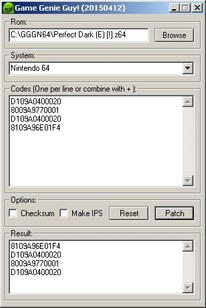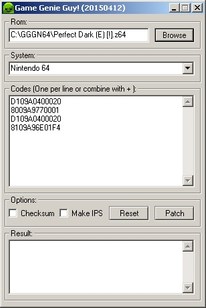First post, by Kerr Avon
Short version: (in case this is a common problem with an often used solution, which I think/hope it might be) :
I am trying to use a Windows program, that as part of it's operation, the windows program opens up a DOS window, and the DOS windows shows the program's progression and error messages. The problem is, the program is failing to perform it's operation, and the DOS window, with the error message, opens and closes almost instantly, so I can't read the error message.
I've tried capturing the screen as a video, but even then the video is too slow to show the open window with it's text. How can I get the DOS window to stay open long enough for me to read it, please?
Long version:
I am using the Windows program Game Genie Guy, available from:
https://web.archive.org/web/20150705171512/ht … iles/GGGN64.zip
this is a rom patcher type program, that converts and inserts Game Genie/Gameshark* codes directly into a rom file, so that when you play that rom file then you get the same effect as if the (virtual or real) console you are playing on has a Game Genie or Gameshark plugged in and is running these same codes.
I am trying to apply the four lines of code:
D109A0400020
8009A9770001
D109A0400020
8109A96E01F4
to the rom:
perfect dark (E)
which is the PAL (European) rom of Perfect Dark for the N64 (I can't provide a link to the rom, for copyright reasons, of course). I have the working Perfect Dark (E) file, and I place a copy in the Game Genie Guy folder. But when I run GGGuy.exe and select the Perfect Dark rom file, specify the Nintendo 64, enter the code and select PATCH, then the DOS windows opens and closes too fast for me to read the error message, and there is no new N64 rom file created, and the existing Perfect Dark rom file (that I selected in the Game Genie Guy window) is untouched (as I can verify by doing a byte by byte comparison of the rom file with the original, from which I created the copy that is in the Game Genie Guy folder).
I've tried all the obvious things that I can think of. None of the files are copy protected, the rom file works (so it's checksum isn't bad or anything), my virus killer isn't causing the problem, etc. It might be that the program is working properly, and in the DOS window it says something like "Sorry, Gameshark codes beginning with D1 are not supported by this program, so no changes will be made to the rom", but I don't know because the DOS window closes too quickly (and this seems unlikely, as the Windows program then shows, in the results area of the GUI, these codes with no error message).
There is an option to fix the checksum after the codes have been added to the rom (because of course by altering the contents of the rom, the checksum is changed), but whether or not that is selected I still get the too-fast-to-read text in the DOS window. NB: you need another program added to the folder to fix the checksum, but even when added the DOS window problem still exists, and the problem seems to be at the adding the codes stage of the process, so leaving the 'Checksum' box blank in the Game Genie Guy Windows program, and not putting the checksum fix program in the folder is OK, it doesn't alter the problem that's causing the codes to not be inserted into the game rom.
* A Gameshark or a Game Genie is a hardware add on that plugs into whatever console it's designed for (the N64, the SNES, the NES, etc) and allows you to run special codes whilst the game is playing. The code you choose might simply continually alter a memory address so that that address is permanently loaded with the value 3, so that the lives counter in the game is never depleted, staying always at 3, so you effectively have infinite lives. Or the code might make it so that when you press a certain button on the controller then one or more addresses are loaded with a pre-defined value(s), or that when you press a certain combination of buttons on the controller then the program counter of the CPU will change to a given value, and the console will continue to execute code from that given memory address. That sort of thing. Mostly these devices are used to add cheats to games or to alter simple game mechanics, but sometimes the results can result in a hundred lines or more of codes, that significantly change a level layout or whatever. Some people are really talented, and make surprising use of these gadgets.

